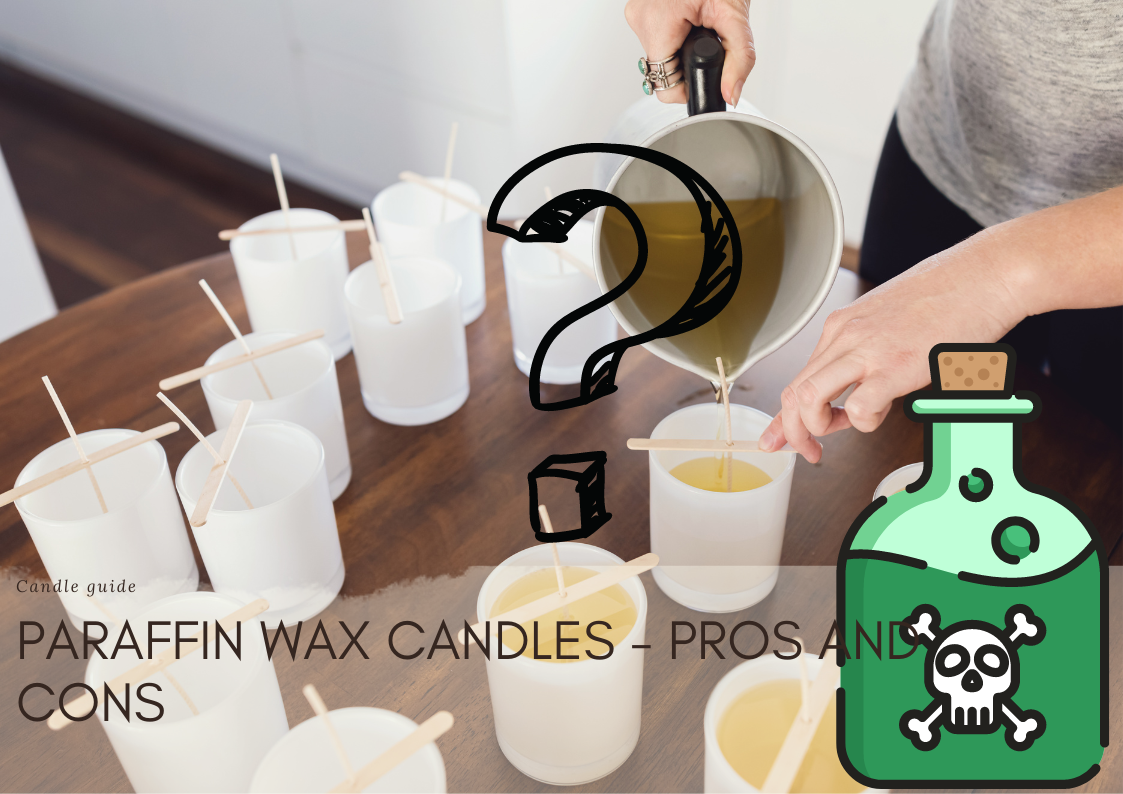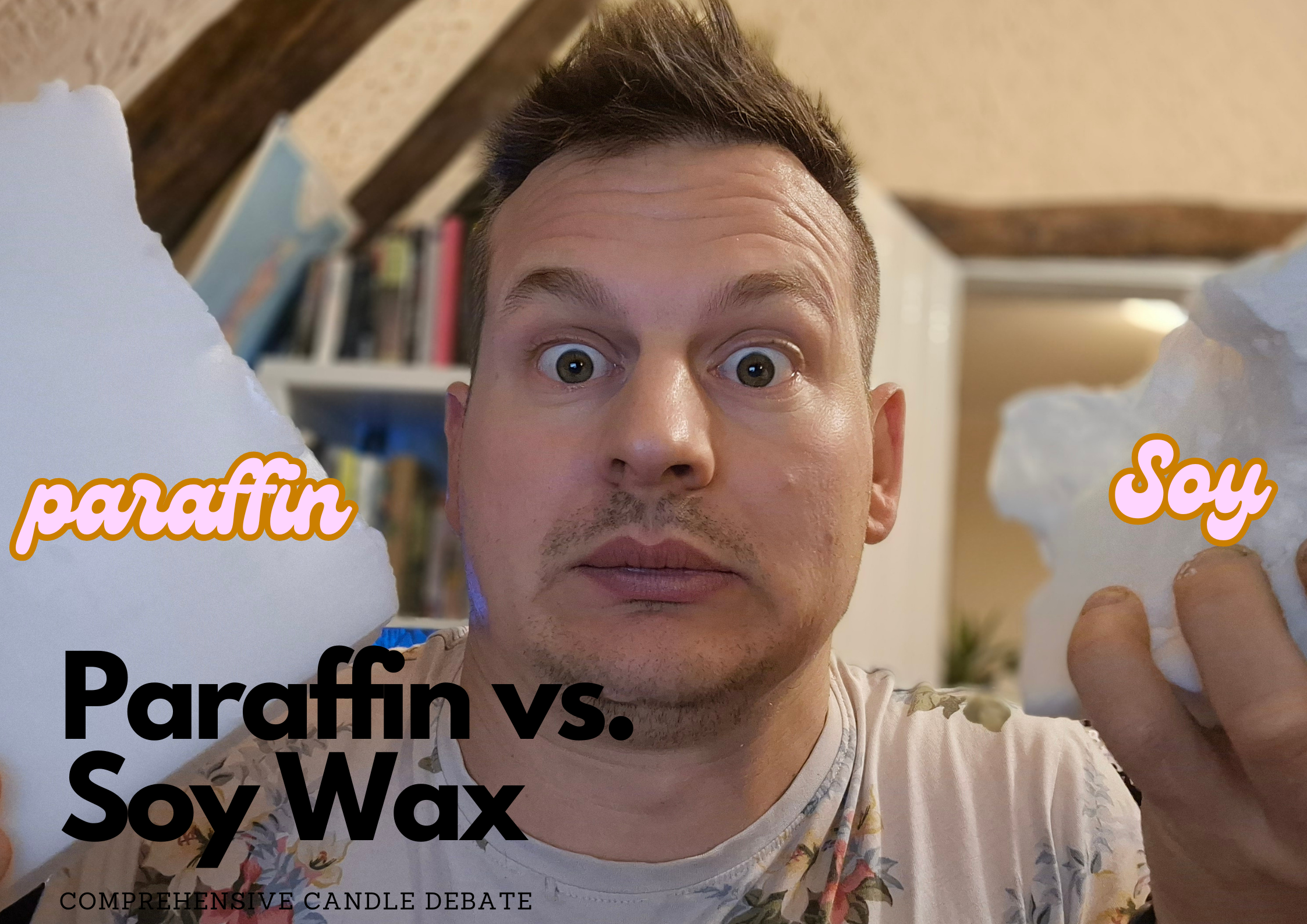Is Paraffin wax toxic? - do candles give off carbon monoxide? The Truth!
Aug 24 , 2022
Paraffin wax candles - pros and cons
Nowadays, paraffin wax is one of the most common materials used in commercially available candles. Paraffin is easy to pour, cheap, it provides long burning times and it takes and holds colours and fragrances very well. But as with anything else, there are some pros and cons to paraffin wax candles, so let's take a look at those!
What is paraffin?
To understand this material thoroughly, we have to know what exactly paraffin is. It is in fact a by-product of the petroleum refining process.
The paraffin candle itself was discovered by scientists experimenting with petroleum oil in the second half of the 1800s, when they noticed that cooled petroleum solidified. When it was poured again to make candles, it produced them with a low melting point and they burned for a long time.
When making paraffin, the crude oil undergoes a dewaxing process to extract the paraffin, which is further purified by various chemical and physical processes after which it still needs to be bleached.
Paraffin wax can be fully-refined and partially-refined. Partially-refined paraffin contains more crude oil and thus more substances that are harmful to health, while fully-refined contains less crude oil and toxins. It is worth noting here that, contrary to misconceptions, only candles made from fully-refined paraffin are sold today, and only this type of wax can be bought in craft shops to make your own candles.
Nowadays, petroleum-based paraffin wax can be found not only in candles but in waxed papers, varnishes, cosmetics and many other commercial articles.
To turn paraffin into candles, it is usually dyed (with chemical dyes), perfumed (with synthetic, petrochemical essential oils), poured into a mould, packaged and shipped to customers.
Is paraffin wax toxic?

Some research suggests that the combustion of paraffin wax releases harmful substances into the air with the smoke. In a 2009 study, researchers at the University of South Carolina claimed that burning candles made from paraffin released harmful substances such as toluene and benzene, which are implicated in the development of asthma and lung cancer. It was also pointed out that burning many candles made from paraffin wax in an unventilated place can cause skin irritation and respiratory problems. However, researchers have also stressed that years and years of exposure to high levels of harmful substances released from paraffin wax are necessary to cause health problems.
Many groups have come out in favour of paraffin candles, such as the European Candle Association (ECA) who even cited an earlier study which found that none of the candle waxes tested produced benzene. According to them, the study conducted in 2009 provided no data, so the claims that they put forward can not be reviewed. The ECA researchers found that the level of toxic chemicals released by paraffin wax was well below the level of posing a danger to humans.
In 2014, an Italian research team studied candles and the toxic substance they emit. Their results showed that candles made from fully refined paraffin wax do not exceed the thresholds set by the World Health Organization (WHO) in any case.
This means that although there are toxic substances released from paraffin when it burns, the amount of these does not pose a risk to our health under normal circumstances.
Do paraffin wax candles give off carbon monoxide?
Carbon monoxide is a colourless and odourless gas, so our senses do not detect its presence, but it is still a very dangerous substance as carbon monoxide poisoning can be life-threatening.
It is a by-product of all combustion (including the burning of candles). Because of this, all candles, regardless of their wax base, emit some of this toxic gas.
However, this amount is so small that under normal circumstances we do not need to worry about it. With all this in mind, there are still a few things you can do to keep yourself safe if you use candles in your home.
Burning a normal sized paraffin candle produces only 10 grams of carbon monoxide per hour, which in itself is not dangerous to your health. The amount of carbon monoxide emitted when a candle is lit depends on the size of the candle and how long it is left burning.
There are some safety measures that you can take if you use candles: keeping your room well ventilated is always a good idea (especially if you have pets with you). Another great safety measure involves you buying a carbon monoxide detector which is a small, smoke detector-sized, battery powered instrument that gives you audible alerts if the concentration of carbon monoxide reaches dangerous levels.
Do paraffin candles produce soot?
Combustion produces not only carbon monoxide but also soot. Soot is a powdery black substance made out of tiny carbon particles produced by the candle flame during incomplete combustion. Just as with carbon monoxide, soot is inherent in all combustion. However, it does matter how much soot is produced when a candle is burnt, as it can also be harmful to our health.
To understand how soot is produced, we need to look at how the candle burns. When the flame of the wick comes close to the wax, the heat melts the top layer of it, which then 'travels' through the wick to provide additional fuel for combustion. When exactly as much wax travels up the wick as it can burn, the combustion is perfect and produces no soot. However, if more wax reaches the flame than how much it can consume, the excess fuel is released into the air as soot.
The amount of soot depends mainly on the type of wax. Beeswax and soy wax produce so little soot that some manufacturers market their products made from these materials as "soot-free" candles. In reality, all candles produce some soot, but there are large variations in the amount. Paraffin candles in particular are notorious for producing a lot of dark black soot when burning, which tends to deposit on the candle holder and in extreme cases can even stain walls and ceilings.
What are the environmental effects of paraffin wax?

Even if the health effects of paraffin wax are not fully understood, its environmental implications are not in doubt. Crude oil, as a raw material for paraffin production, is not at all sustainable, it is a non-renewable raw material. It is the cause of many environmental disasters and one of the main contributors to climate change.
Many candle brands are trying to replace paraffin in their candles, although it is always worth taking a closer look at the sustainability of these new materials. Waxes made from palm oil can put rainforests at risk, so make sure that if you buy one of these candles, it is made from responsibly sourced palm wax. The same applies to soy wax, but this has to be transported less if you plan to use your candles in America, so the carbon footprint of transport is lower than if it were from Europe. Rapeseed wax may be an appropriate choice if you live in Europe because it is mostly produced there, and the quality of the raw material is more controllable and vegan. Candles made from beeswax can also be a good choice, and are available at many craft fairs.
The pros and cons of paraffin:
Now that we know what paraffin wax is, how it is made and what physiological effects it has, let's see if it is worth using this wax base for our own candles.
Let's start with the pros:
-
It provides a nice, high, bright candle flame.
-
It has to be re-lit less times than other candles.
-
It is easy to use it in our home made candles.
-
It is flammable enough to burn for several hours
-
Because it burns at relatively high temperatures, the added fragrances fill the air easily and quickly.
And now, the cons:
-
Although scientific research has not yet proven this 100%, paraffin wax can release toxic substances when burnt, which can lead to health problems if inhaled.
-
Paraffin forms more soot during combustion than other wax alternatives.
-
Paraffin is a non-renewable energy source and its production releases pollutants into the atmosphere
-
It produces much more soot than candles made from natural waxes.
As we have seen from the above, paraffin wax has some serious drawbacks in addition to its many positive aspects.
As with everything else, the best thing to do when using paraffin candles is to use them in moderation: lighting a few candles in a well-ventilated room should not cause any health problems.
Of course, in deciding which type of candle to use or which wax to buy for your own DIY candle making project, several factors will influence you. One of them - perhaps the most important one today - is the impact of paraffin wax (or rather its production) on the environment. Paraffin must compete with numerous waxes made from renewable sources.





